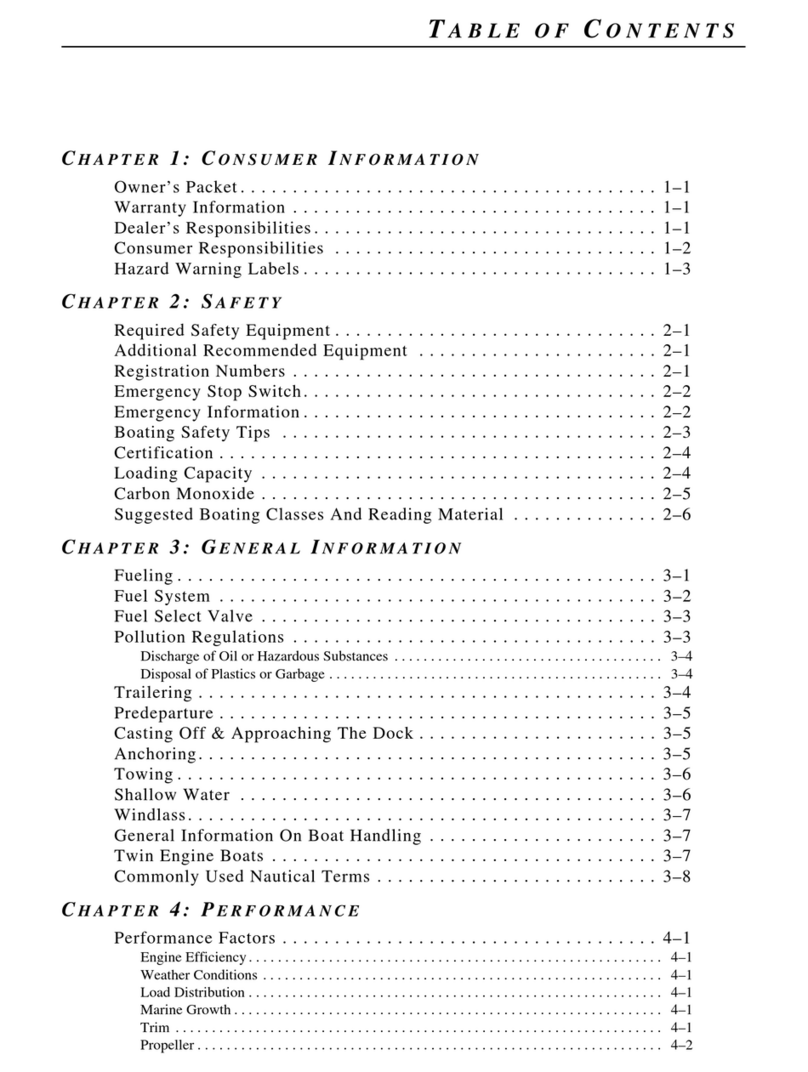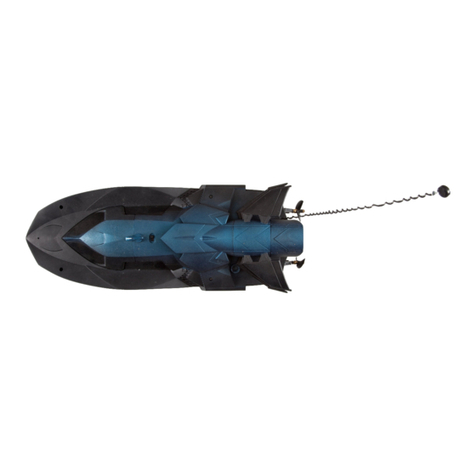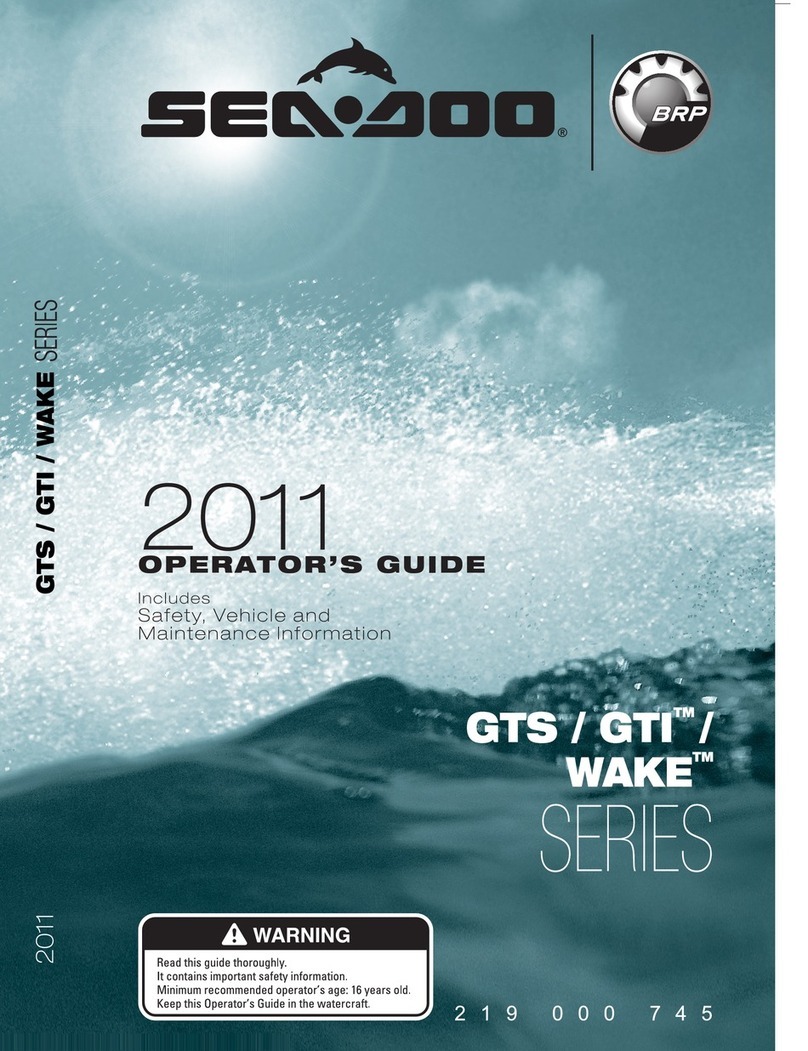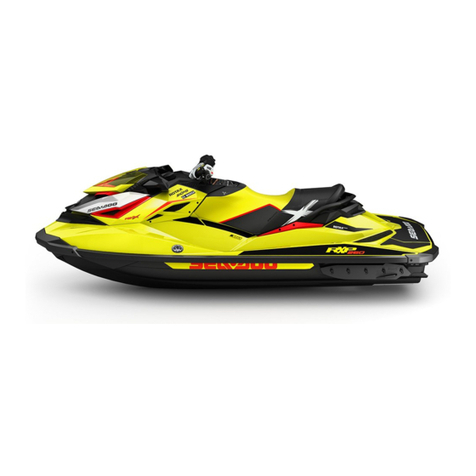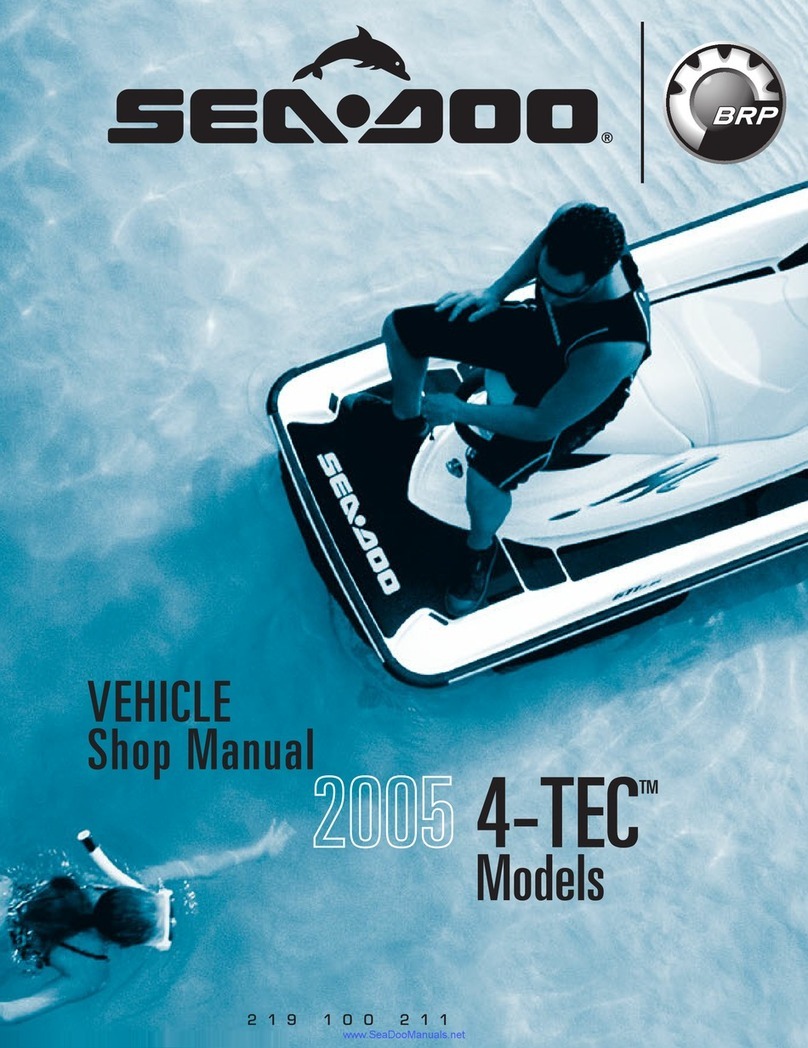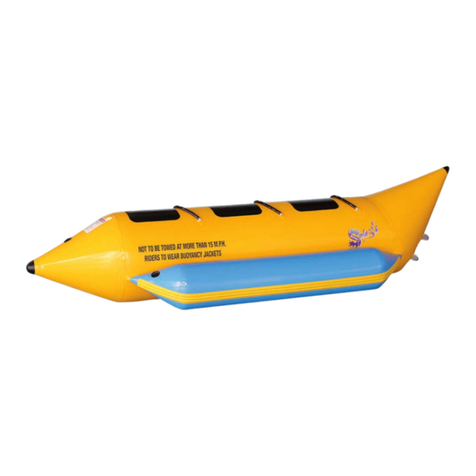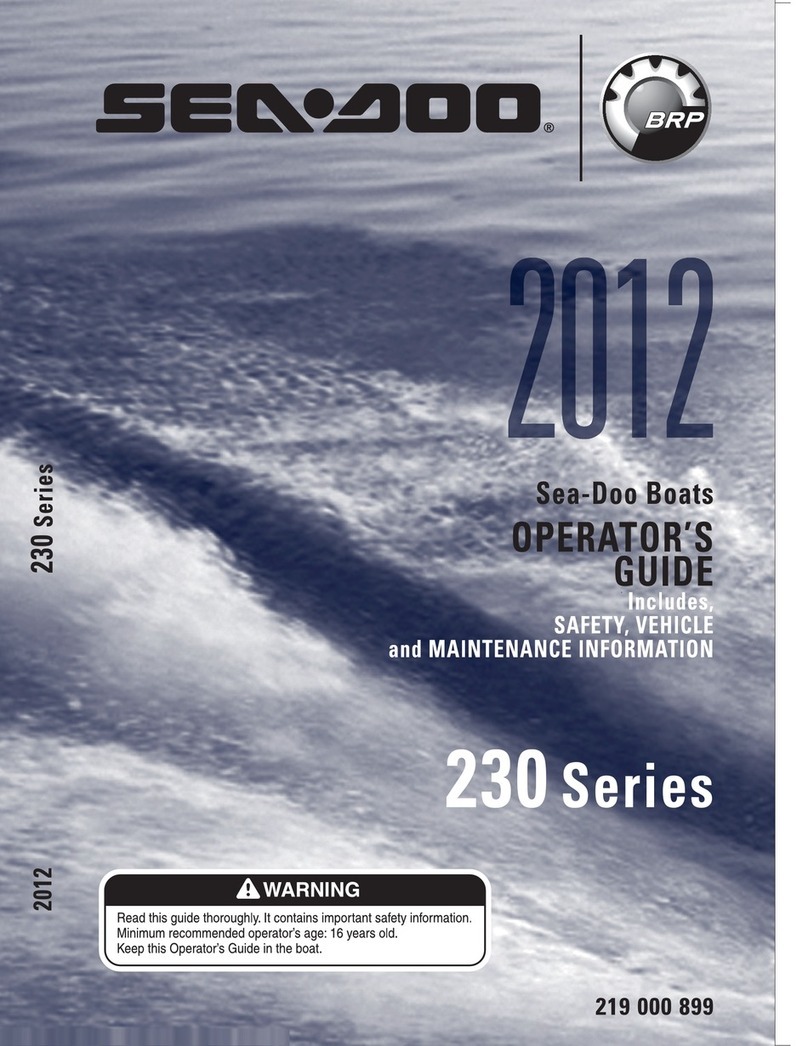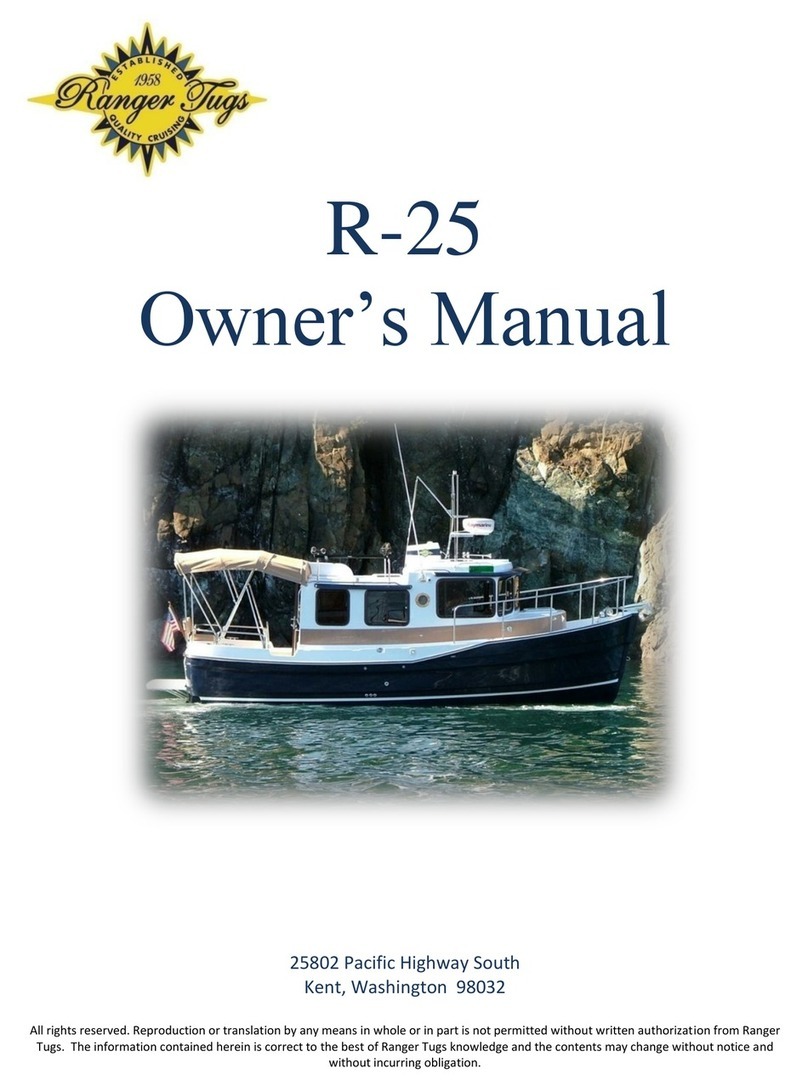DinghyGo Nomad 230 User manual

the inflatable sailboat
Owner’s Manual

DinghyGo, the inflatable sailboat owner’s manual
1. Index
1. Index 2
2. General information 5
2.1.Introduction 5
2.2.CE Category 6
2.3.ABYC Standard 6
2.4.Builders's plate (capacity label) 7
2.5.National regulations 7
2.6.General safety information 7
3. Specifications, description and functions 9
3.1.Specifications 9
3.2.Model 10
3.3.Capacity 10
3.4.Deadweight tonnage 10
3.5.Sail kit 10
3.6.Outboard motor 11
3.7.Visual representations 12
4. Assembly and disassembly 16
4.1.Inflatable floor 16
4.2.Valves 16
4.2.1.Using the valves 16
4.2.2.Pump connections 16
4.2.3.Checking for leaks 16
4.3.Rowing kit 17
4.4.Sail kit 17
4.5.Seating 17
4.6.Inflating the tubes 17
4.6.1.Order in which to inflate 17
4.6.2.Inflating the hull tubes 17
4.7.Inflating the inflatable floor 18
4.8.Assembly and disassembly of the sailing rig 18
4.8.1.Installation of the mast step board, seat and bridle 18
4.8.2.Inflation of the boat 18
4.8.3.Rigging 19
4.8.4.Preparation before going into the water 19
®©
Page /2 39
May 2020

DinghyGo, the inflatable sailboat owner’s manual
4.8.5.Sailing 20
4.8.6.Disassembly 20
4.8.7.Removal of the mast step board and seat 20
4.8.8.Packing up and storing the sail kit 21
4.9.Installation of the oars 21
4.10.Installation of an outboard motor 21
4.10.1.Mounting the outboard motor 22
4.10.2.Position of the outboard motor 22
4.10.3.Starting the outboard motor 22
4.11.Deflation of the boat 23
4.12.Packing up and storing the boat 23
4.13.Transport 23
4.13.1.Getting the boat out of the water 23
4.13.2.Towing the boat 23
5. Recommendations for safety and use 25
5.1.Important safety instructions 25
5.2.Essential checklist before use 26
5.3.Stability and buoyancy 28
5.3.1.Placement of passengers and personal items 28
5.3.2.Sailing 28
5.3.3.Rowing 28
5.3.4.Outboard motor 28
5.4.Danger, risks and hazards 30
6. Maintenance 32
6.1.General Maintenance 32
6.2.Repairs 32
6.2.1.Small repairs 32
6.2.2.Leakage in tubes or floor due to tearing 33
6.3.(Winter) Storage 34
7. The environment 35
7.1.Disposal of polluting substances 35
7.2.Removal and disposal of waste 35
7.3.Recommended speed limits 35
7.4.Noise pollution 35
7.5.Exhaust emissions 35
®©
Page /3 39
May 2020

DinghyGo, the inflatable sailboat owner’s manual
2. General information
2.1. Introduction
This user manual has been composed
to ensure the safety and
entertainment of your DinghyGo
Inflatable 3-in-1 sailing boat. This
manual contains detailed information
on the watercraft, its equipment, its
systems and information on its use
and maintenance. Please read this
manual and review the DinghyGo
instruction videos with care; it is
important that you are familiar with
the watercraft before use.
This user manual does not offer a
course in safety and good
seamanship. If this is your first
experience with a watercraft, or if
you are not familiar with this
particular type of watercraft, please
make sure you ensure your own
safety and comfort by gaining
experience in both steering and using
a watercraft (sailing and motor boat)
before using your DinghyGo
watercraft.
Your DinghyGo supplier, national
sailing federation or yacht club will be
on hand to offer advice on local
sailing schools and sailing clubs with
qualified instructors. Make sure your
DinghyGo is suitable for the
anticipated wind and sea conditions,
and that you and your crew are able
to manage the boat in these
conditions.
This owner’s manual does not
provide a detailed guide for
maintenance or repairs of the boat.
If problems occur, please consult
your DinghyGo supplier. Follow the
maintenance and repair instructions
provided in this manual for proper
maintenance and repair of your
DinghyGo. Always consult trained
and competent specialists for
maintenance, repairs or alterations.
Changes that are made to the boat
that may affect the safety of the
watercraft may be assessed,
executed and documented by
competent people only. Your supplier,
Aquacrafts, cannot be held
responsible for modifications that
were not approved by them. In some
countries, a licence or permit is
required to operate this watercraft,
and sometimes specific rules apply.
Always make sure your watercraft is
well maintained and please take into
account that wear and tear will occur
over time, especially due to heavy
use or misuse of the watercraft.
Every boat is made to be robust, but
your boat can be seriously damaged
if used incorrectly. Always adjust the
speed and direction of the boat
according to your surroundings. The
crew must be familiar with the use of
all safety and emergency procedures
(man overboard, towing, etc.).
Sailing schools and clubs regularly
organize training sessions to help you
if necessary.
In some countries, wearing a life
jacket or buoyancy aid that meets
the national regulations is obligatory
at all times.
®©
Page /5 39
May 2020

DinghyGo, the inflatable sailboat owner’s manual
☝In this manual, the following
safety warnings are used to draw
your attention to special safety
instructions that must be followed:
Please keep this manual in a safe
place and pass this manual to the
new owner if you choose to resell
your DinghyGo.
2.2. CE Category
Your DinghyGo is meant to be used
as a Category D watercraft:
Category D. A watercraft designed for
use in wind up to, and including,
Force 4 on the Beaufort Scale, and
the corresponding significant wave
height up to, and including, 0,3
meters, with occasional waves of 0,5
m maximum height.. Such conditions
are found in sheltered coastal and
inland waters, including small bays,
small lakes, rivers and canals in good
weather conditions.
☝The wave height is the average
height of the highest one third of the
waves, which approximately
corresponds to the wave height as
estimated by an experienced
observer. Some waves, however, can
be twice as high.
2.3. ABYC Standard
Your DinghyGo complies to the
American Boat & Yacht Council
(ABYC) H-28 Type 1 Inflatable Boats
standard.
®©
Page /6 39
May 2020
⚠WARNING
WARNING – indicates a potentially
hazardous situation that could
result in injury or death if not
avoided.
⚠DANGER
DANGER – indicates an imminent
hazardous situation that could
result in injury or death if not
avoided.
⚠WARNING
Take proper precautions if the
watercraft is used from a
mothership on the open sea. Never
lose touch with the mothership!
Always wear a life jacket!
⚠CAUTION
CAUTION – indicates a potentially
hazardous situation that could
result in minor or moderate injury
or property damage if not avoided.
This indication may also warn
against unsafe practices.

DinghyGo, the inflatable sailboat owner’s manual
2.4. Builders's plate
(capacity label)
The builders’ plate including
information from DinghyGo producer
Aquacrafts is located on the inside of
the boat’s transom.
Representation of the Builder’s Plate
(Orca 325)
Explanation of the Builder’s Plate:
a. Manufacturer’s name
b. Boat model, type and version
c. Boat category - see Table 2.1
d. CE marking
e. ISO 6185 part & type
f. Maximum load (people +
outboard motor + fuel +
equipment)
g. Maximum power and outboard
motor weight
h. Maximum capacity / number of
persons
i. Maximum sail area
j. Maximum pressure of the air
chambers and floor
2.5. National regulations
Before preparation, check local
regulations to see if there are
restrictions for the water you want to
go on. Be especially cautious of
restrictions with regard to sail,
speed, the use of the sail kit or
outboard motor, noise restrictions on
the water, etc.
2.6. General safety
information
☝Advice for safe sailing
In order to safely enjoy the
waterways, you should be familiar
with local and other governmental
boating regulations and restrictions.
Please consider the following
suggestions:
•Use life jackets or buoyancy aids.
Make sure that a suitable life jacket
or buoyancy aid is available for
each person on board which are
easily accessible (mandatory by law
in some countries).
•Do not exceed the maximum rated
load. If in doubt, contact your
DinghyGo supplier.
•Perform safety checks and required
maintenance. Follow a regular
schedule and ensure that all repairs
are done properly.
•Make sure you know all applicable
nautical rules and laws and follow
them.
☝Make sure everyone in the boat is
properly seated. Do not sit on any
part of the boat or sailing rig that
was not intended for seating.
This includes the transom edges, the
bow and the deck, where sudden
unexpected acceleration might take
one off balance. Sudden stopping,
unexpected loss of control over the
boat or sailing rig, and sudden boat
movement could cause a person to
be thrown overboard or into the
boat.
®©
Page /7 39
May 2020

DinghyGo, the inflatable sailboat owner’s manual
☝Make sure you are NEVER under
the influence of alcohol or drugs
while boating (mandatory by law).
Alcohol and drug use have an
adverse effect on your judgment and
greatly reduce your ability to react on
the water.
When possible, prepare others on the
boat in case the operator is
incapacitated or falls overboard:
instruct at least one other person in
the basics of sailing, starting and
operating the outboard motor, and
steering the boat.
☝Stop the outboard motor
whenever passengers are boarding,
unloading, or are located on the back
of the boat. Simply switching the
outboard motor to neutral is not safe
enough.
Pay attention. The operator of the
boat is responsible by law to properly
watch and listen. The operator must
have an unobstructed view,
particularly to the front. The
passengers and load must not
obstruct the operator's view when
the boat is moving.
☝Never steer your boat directly
behind a water-skier (or wake-
boarder), as they might fall. If the
water skier is travelling 61 m (200
ft.) in front of you and your boat is
travelling at a speed of 20 km / h
(12.5 mph) it will only take you ten
seconds to overtake him.
Be aware of falling water skiers. The
operator must always be able to see
the fallen skier and must never back
up to the skier or anyone in the
water. Report all accidents.
®©
Page /8 39
May 2020

DinghyGo, the inflatable sailboat owner’s manual
3. Specifications,
description and
functions
3.1. Specifications
The DinghyGo models fall under the
protection of the recreational Craft
Directive 2013/53/EU. The DinghyGo
Nomad 230 model is not covered by
this Directive because of its length,
but is constructed in such a way that
it meets the requirements and the
ISO 6185 standards. An example of a
statement of compliancy has been
added as an Appendix to this
manual.
®©
Page /9 39
May 2020
DinghyGo model specifications
*) Specications can dier by 5% **) Weights and optimal packing sizes excluding carton, packing materials & bag.
model
Nomad 230
Orca 280
Orca 325
Orca 375
Boat specifications
CE category
n.a.
D
D
D
Number of air chambers
3
3
3
3
Dimensions and weight*
length (ft/cm)
7’5”/230
9’2”/280
10’7”/325
12’3”/375
width (ft/cm)
4’9”/150
4’9”/150
4’9”/150
4’9”/150
draft (ft/cm)
2’8”/85
2’8”/85
2’8”/85
2’8”/85
tube diameter (in/cm)
16”/40
16”/40
16”/40
16”/40
weight (lbs/Kg)
51/23
60/27
64/29
71/32
Capacity (maximum)
persons (without/with rigging)
3/1
4/2
5/2,5
6/3
payload (lbs/Kg)
825/375
1,100/500
1,265/575
1,430/650
outboard engine power (kW/Hp)
1.9/2.5
4.5/6.0
4.5/6.0
4.5/6.0
outboard engine weight (lbs/Kg)
42/19
66/30
66/30
66/30
pressure tubes/floor (psi)
3.6/2.7
3.6/10.2
3.6/10.2
3.6/10.2
Packing size** (LxWxH in)
40”x20”x12”
40”x21”x13”
40”x28”x13”
40”x28”x15”
Packing size** (LxWxH cm)
100x52x30
100x54x32
100x72x32
100x72x38
Sail/row-kit specifications
Dimensions and weight*
mast length (ft/cm)
11’3”/345
11’3”/345
14’1”/430
14’1”/430
boom length (ft/cm)
5’8”/178
6’7”/205
7’4”/225
7’4”/225
sail area (sq.ft/m2)
34/3.2
42/3.9
60/5.6
64/5.9
weight (lbs/Kg)
29/13
31/14
33/15
37/17
Packing size** (LxWxH in)
46”x18”x6”
46”x18”x6”
47”x18”x7”
47”x18”x8”
Packing size** (LxWxH cm)
118x45x15
118x45x16
120x45x18
120x45x20

DinghyGo, the inflatable sailboat owner’s manual
3.2. Model
DinghyGo is an inflatable three-in-
one sailboat that acquires its shape,
strength and buoyancy by being filled
with air. The boat is designed for
small voyages in sheltered and open
waters, as indicated in section “CE
Category”. The different DinghyGo
models are specified in the Model
specifications table.
3.3. Capacity
3.4. Deadweight tonnage
The maximum recommended load
strictly includes:
a. The number of persons 75 kg
each. If children are taken as
crew, then the maximum number
of people may be increased
provided that the weight of each
child is not more than 37.5 kg and
the total weight is not exceeded;
b. Basic equipment including sail kit
and rowing parts;
c. Stock and load (if any), dry
facilities, consumable liquids [not
covered in d.] and a variety of
equipment which is not a part of
the weight of the boat or
mentioned in b., including
outboard motor;
d. Useful liquids (fresh water, fuel)
filled to its maximum capacity in
portable tanks.
3.5. Sail kit
The maximum sail area of the sailing
rig (sail kit) is shown in the "model
specification table" and on the
capacity information notice.
The installation and use of the sail kit
are described in the chapters called
"Assembly and disassembly”,
“Recommendations for safety and
use" and Appendix “Assembly
Rudder/Orca boom …” in this manual.
®©
Page /10 39
May 2020
⚠WARNING
When loading the watercraft, never
exceed the maximum
recommended load. Always use
caution when loading the watercraft
and distribute loads appropriately
to maintain proper buoyancy.
Avond placing heavy weight in high
places.
⚠WARNING
Using a sail kit that is too big or
unoriginal can severely damage the
watercraft or cause personal injury,
especially when there is too much
wind. Always use the original and
matching DinghyGo sail kit, which
is less than or equal to the
specified maximum sail area. Never
sail with more wind than the
specified maximum wind speed in
the section “CE Category”
⚠Warning
Do not exceed the maximum
number of people. Regardless of
the number of persons aboard, the
total weight of persons and
equipment must never exceed the
maximum recommended load.
Always use the seat / seating.

DinghyGo, the inflatable sailboat owner’s manual
3.6. Outboard motor
The maximum power of this boat is
shown in the "model specification
table" and on the capacity
information notice.
The installation of the outboard
motor and further operating
instructions are described in the
chapter called "Assembly and
disassembly" in this manual.
®©
Page /11 39
May 2020
⚠DANGER
Using an onboard motor at
maximum power setting can result
in serious injury, death or damage
to the watercraft.
⚠DANGER
You could lose control of the boat
when using the onboard motor at
full speed. Accidents may occur.
The supplier (Aquacrafts) cannot be
held responsible for these actions.
⚠WARNING
Be careful when refueling, i.e. don’t
smoke and clear up all spilt fuel. Be
careful when installing the outboard
motor to prevent damage to the
fuel hose. Make sure no
combustible materials can come
into contact with engine parts.

DinghyGo, the inflatable sailboat owner’s manual
3.7. Visual representations
®©
Page /12 39
May 2020
Legenda
1. Mast sleeve
2. Sail batten
3. Telltale
4. Clew
5. Outhaul
6. Boom outboard end
7. Mainsheet block with
becket
8. Mainsheet
9. Mainsheet block with
snap shackle
10. Velcro strap
11. Boom clamcleat
12. Boom rear section
13. Mainsheet block
14. Boom front section
15. Pinstop downhaul
16. Downhaul
17. Boom inboard end
18. Mast lock system
19. Deck board
20. Mast clamcleat
21. Velcro strap
22. Tack
23. Maststep
24. Maststep board
25. D-ring
26. Daggerboard
27. Socket
28. Pocket
29. Drain plug
30. Rudder
31. Rudder pintle
32. Rudder
gudgeon
33. Transom
34. Rudder retaining
clip
Sideway view
(Orca 280)

DinghyGo, the inflatable sailboat owner’s manual
®©
Page /13 39
May 2020
Legenda
Additional items shrouds mast support
(main sail > 3,9m2)
60. Mast sleeve opening
61. Mast eyelet
62. Shroud shackle
63. Shroud
64. Shroud cleat
65. Shroud/davits D-Ring
Additional items jib
66. Halyard
67. Halyard shackle
68. Jib head
69. Jib
70. Halyard cleat
71. Jib tack
72. Jib shackle (clew)
73. Bow D-ring
74. Jib clew
75. Jib sheet
76. Jib sheet D-ring
Sideway view
(Orca 375)

DinghyGo, the inflatable sailboat owner’s manual
®©
Page /14 39
May 2020
Legenda
35. Valve oor (no. 4)
36. Valve (no. 1)
37. Deck board
38. Handle bow
39. Mast collar
40. Maststepboard stopper
41. Over pressure valve
42. Davits eye
43. Over pressure valve
oor
44. Seat/daggerboard
holder
45. Rope
46. Seat tendon
47. 3D oor
48. Oar lock
49. Oar
50. Valve (no. 3)
51. Handle (rear)
52. Bridle
53. Transom motorpad
54. Transom motorplate
55. Tiller
56. Carabine hook
57. Davits- and bridle eye
58. Valve (no. 2)
59. Handle (rear)board
View from the top
(Orca 280)

DinghyGo, the inflatable sailboat owner’s manual
®©
Page /15 39
May 2020
legenda
1. Rudder blade
2. Bolt retainer
3. Tiller holder (end)
4. Tiller
5. Tiller spring lock
6. Tiller holder (front)
7. Pintle holder (top)
8. Pintle
9. Retaining clip
10. Rudderhead
11. Pintle holder (bottom)
12. Pintle
13. Bolt cap
14. Bolt
15. Wing nut
16. Rudder head (right)
17. Rudder blade
18. Rudder head (left)
19. Bolt retainer
20. Bolt head
Kick-up rudder
Rear view
Sideway view

DinghyGo, the inflatable sailboat owner’s manual
4. Assembly and
disassembly
☝Look closely at the DinghyGo
instructional videos on assembling
and disassembling the watercraft.
You will receive these instruction
videos with your DinghyGo. You can
also order these from your DinghyGo
supplier.
4.1. Inflatable floor
The DinghyGo boats are equipped
with an inflatable floor that needs to
be filled properly. Using the boat
without a properly inflated bottom is
unsafe, uncomfortable and can lead
to damage to the boat. Look at the
section called "inflating the inflatable
floor" to learn how to fill the
inflatable floor.
4.2. Valves
The boat valves are designed
especially for safe and comfortable
use. The flat valves are designed to
increase the comfort in the boat and
to prevent damage to the boat.
image of a valve
4.2.1. Using the valves
•Remove the outer cap. The valve is
closed when the middle screw knob
is on top.
•To open the valve put your finger
on the centre of the valve and press
down the centre screw button. Turn
your finger ¼clockwise until the
knob locks.
•To close the valve, press the knob
and turn your finger ¼clockwise
until the knob comes up.
4.2.2. Pump connections
•Attach the nozzle of the pump (the
tip part) to the valve.
•Turn it to the right (clockwise) until
it locates, and start pumping.
•Keep pumping until the boat is
completely full.
•Unplug the pump when finished.
•Make sure the cap is put back on
(to protect against dirt and
damage).
4.2.3. Checking for leaks
If air escapes:
•Take the valve key out of the repair
kit.
•Insert the key into the valve and
turn the key clockwise. Check if the
problem is resolved.
•When a leak is discovered, contact
your DinghyGo supplier and check
the warranty.
•Take the back of the valve into your
hands and turn the stem to the left
with the key (counter clockwise)
and remove the stem.
•Inspect the valve for damage.
•If there is any damage (see
appendix "Warranty"), take the
defective valve to your DinghyGo
supplier. You will receive a new
valve within the warranty period.
•Lubricate the stem with silicone or
soapy water and reinstall it.
®©
Page /16 39
May 2020

DinghyGo, the inflatable sailboat owner’s manual
4.3. Rowing kit
There are two oars supplied with the
boat. The blades can be removed
from the shafts to facilitate
transportation. The oars should be
placed in the oarlocks.
4.4. Sail kit
Your DinghyGo is supplied with a sail
kit, consisting of:
•Seat / daggerboard case
•Mast step board
•Daggerboard
•Rudder
•Sectional mast
•Sectional boom
•Sail
•Rope Set (Orca 4.8 and 5.6m2 rigg
includes additional supporting
shrouds with cleats and shackle)
•Sail kit bag
The installation and rigging of the
sailing equipment is explained later
in the manual including its Appendix.
4.5. Seating
DinghyGo is equipped with a special
seat and a "seat cord" on both side
tubes, onto which the seat is pushed.
The seat also functions as the top
slot for the daggerboard (case).
☝You must install the seat before
fully inflating the boat.
4.6. Inflating the tubes
Roll out the boat onto the ground to
fill it up with air. Remove any sharp
objects from the surface on which
the boat is inflated.
•After unpacking the boat, check if
all the components are present.
•Check that the valves are closed.
This is done by putting a finger in
the valve, pushing the little grey
screw button and turning it slightly
to the right.
•If the knob jumps up a little, you
can proceed to fill the boat with air.
(To drain air out of the boat you
have to turn the knob to the left!).
•Use the pump that was provided
with the boat. Push the nozzle (the
tip) against the valve and turn to
the right. The pump will lock onto
the valve.
•Put enough air in the boat to create
the correct shape of the boat.
☝All inflatable chambers must be
inflated equally to avoid damage to
the bulkheads.
☝Inflating and deflating your boat
the right way is essential to the
durability of your boat.
4.6.1. Order in which to
inflate
Inflate the boat in the ascending
order of the numbers that are on the
valve tags:
1) Front chamber (no. 1)
2) Side-chambers (no. 2 & 3)
3) Floor (no. 4)
4.6.2. Inflating the hull
tubes
Step 1: Pump air into the front
chamber using the inflation valve
until the specified pressure is
reached.
Step 2: Pump air into the two side-
chambers in the correct order until
the specified pressure is reached.
If inflation is carried out in the
correct order, the boat will have the
®©
Page /17 39
May 2020

DinghyGo, the inflatable sailboat owner’s manual
correct pressure and there will not be
any deformation of the float sections.
Step 3: Seal all the valves by
inserting the valve caps and turning
them clockwise.
☝Never exceed the values on the
builder's plate and valve tags! Inflate
the boat floats to 0.25 bar = 3.6 psi
= 25 kPa and the floor to 0.19 bar =
2.75 psi = 19 kPa (tolerance ±20%).
Inflate the Orca floor to 0.7 bar =
10.2 psi = 70 kPa.
☝Do not use mechanical
compressors to inflate your boat. The
included hand pump is adjusted to
create the perfect pressure for your
boat. If preferred, you could use an
electric pump that can be provided as
an option by your DinghyGo supplier.
Use the correct pressure settings to
properly facilitate inflation.
4.7. Inflating the
inflatable floor
If you fully inflate the inflatable floor,
it clamps in between the side tubes
and the transom.
Step 1: Pump air into the bottom
through the valve, like the side
tubes, until the specified pressure is
reached.
Step 2: Seal the valve by inserting
the valve cap and rotating clockwise.
4.8. Assembly and
disassembly of the
sailing rig
The sail kit bag contains the
complete sailing equipment. Lay out
all sail components to facilitate
installation and rigging.
4.8.1. Installation of the
mast step board, seat
and bridle
•Partially inflate the bow and side
tubes (read the section "inflating
the hull tubes”), so that they have
some shape but are not fully up to
pressure. Do not inflate the floor
yet.
•Slide the mast step board in under
the tubes until it locates in front of
the mast step board stoppers on
the floor (at front of boat).
•Slide the seat / daggerboard case
onto the seat cords on the tubes,
until it is located directly above the
daggerboard case opening in the
bottom.
•Tie one end of the bridle onto the
transom eye and attach the other
end to the other transom eye with
the carabiner.
4.8.2. Inflation of the boat
•Inflate the hull tubes and floor
completely (read the paragraph
"inflating the hull tubes" and
"inflating the inflatable floor"), in
such a way that the mast step
®©
Page /18 39
May 2020
⚠CAUTION
Incorrect inflation can cause
structural damage to your
watercraft. Take your watercraft out
of direct sunlight when outside of
the water. Direct sunlight causes
the air in the watercraft to expand,
causing damage to your watercraft
(except through proper use and
maintenance of the pressure relief
valve).

DinghyGo, the inflatable sailboat owner’s manual
board and seat / daggerboard case
are firmly clamped.
•Then attach the flexible part of the
daggerboard case with the Velcro
on the bottom of the seat /
daggerboard case.
•Attach the oars (read the paragraph
“installation of the oars").
4.8.3. Rigging
•Make sure the rudder and Orca
boom are correctly assembled after
unboxing in accordance with the
Appendix.
•Slide the mast and boom sections
together.
•Take the sail and insert the sail
battens.
•Slide the mast into the mast sleeve
of the sail.
•Attach the supporting shrouds
through the mast sleeve opening
with the shroud shackle to the top
mast eye (Orca 4.8 and 5.6m2 rigg
only)
•Place the mast in the mast step,
through the deck hole, and lock the
mast under the deck with the push-
button system (Nomad only).
•Attach the supporting shrouds to
both sides of the tubes by leading
the shroud through the D-ring and
secure it in the shroud cleat. Make
sure the mast stands straight with
just a little shroud tension (Orca
4.8 and 5.6m2 rigg only).
•Attach the boom to the mast by
snapping the front end of the boom
to the mast.
•Attach both of the Velcro straps
from the sail to the boom.
•Apply the downhaul and outhaul
with the correct tension.
•Attach the mainsheet block with
snap shackle to the bridle.
4.8.4. Preparation before
going into the water
•Attach the rudder to the transom.
Ensure that the rudder is locked
with the rudder retaining clip.
•Slide the daggerboard through the
seat into the daggerboard case.
•Close the self-bailer.
☝The daggerboard has to be
inserted into the daggerboard case
with the blunt profile aimed to the
bow.
☝The bridle has to be attached over
the tiller of the rudder.
®©
Page /19 39
May 2020
⚠WARNING
Make sure the sailing rig is properly
inserted into the mast step and
that the mast is locked underneath
the deck with the push-button
system. The improper attachment
of the sailing rig can lead to the
loosening of the sailing rig which
can cause the watercraft to get out
of control and may cause injury to
the crew
⚠WARNING
Make sure the mast stands straight
and is properly supported by the
shrouds (Orca 4.8 and 5.6m2 rigg)
attached to the mast and both
sides of the tubes. The improper
attachment of the supporting
shrouds can lead to the loosening
of the sailing rig which can cause
the watercraft to get out of control
and may cause injury to the crew

DinghyGo, the inflatable sailboat owner’s manual
4.8.5. Sailing
This manual does not provide sailing
instructions and assumes that the
operator and passengers have
adequate sailing experience and
qualifications. Your DinghyGo
supplier or sailing club is able to
inform you of training opportunities,
such as sailing courses.
4.8.6. Disassembly
•Take the rudder off of the transom
by pressing/releasing the rudder
retaining clip.
•Remove the daggerboard from the
daggerboard case and seat.
•Disconnect the mainsheet block
from the bridle by opening the snap
shackle.
•Detach the supporting shrouds from
both sides of the tube D-rings by
releasing the shrouds from the
shroud cleats (Orca 4.8/5.6m2).
•Raise the sailing rig out of the mast
step through the deck, after
pressing the push-button system on
the mast below deck.
•Release the outhaul and downhaul
and detach the boom from the
mast.
•Take the boom sections apart.
•Remove the battens from the sail,
detach the supporting shrouds from
the mast by releasing the shroud
shackle (Orca 4.6 and 5.6m2 rigg
only) and pull the mast sleeve off of
the mast.
•Take the mast sections apart.
4.8.7. Removal of the mast
step board and seat
•Partially deflate the floor and side
tubes (read the paragraph on
"deflation of the boat"), in such a
way that it still has shape but is not
pressurised.
•Detach the flexible portion of the
daggerboard case from the
underside of the seat.
•Slide the seat backward from its
mounting tendons on the floats.
•Pull the mast step board out of the
stoppers from the bow of the boat.
Lifting the bow with one hand
makes it easier to take out.
•Take out the oars from the oarlocks
and take apart the oars.
®©
Page /20 39
May 2020
⚠WARNING
Attach the rudder with the retaining
clip. Incorrect securing can lead to
the loss of the rudder and
consequent loss of direction of the
watercraft, which can lead to life
threatening situations.
⚠WARNING
Always secure the tiller in the
rudder head before sailing. The
rudder can otherwise be damaged
and lead to loss of direction of the
watercraft which could result in life
threatening situations.
⚠WARNING
Only sail once you and your crew
have adequate sailing experience
and can guarantee you know how
to react to the (expected)
conditions, safety hazards, the
performance of individuals and the
workings of the watercraft. Make
sure the equipment of the crew and
the watercraft is valid. Improper
use, faulty equipment and
unsuitable conditions can cause life
threatening situations.
This manual suits for next models
3
Table of contents
Popular Boat manuals by other brands

Sea Eagle
Sea Eagle HB96 Instruction & owner's manual

Bavaria
Bavaria 33 2006 Information & operations manual for
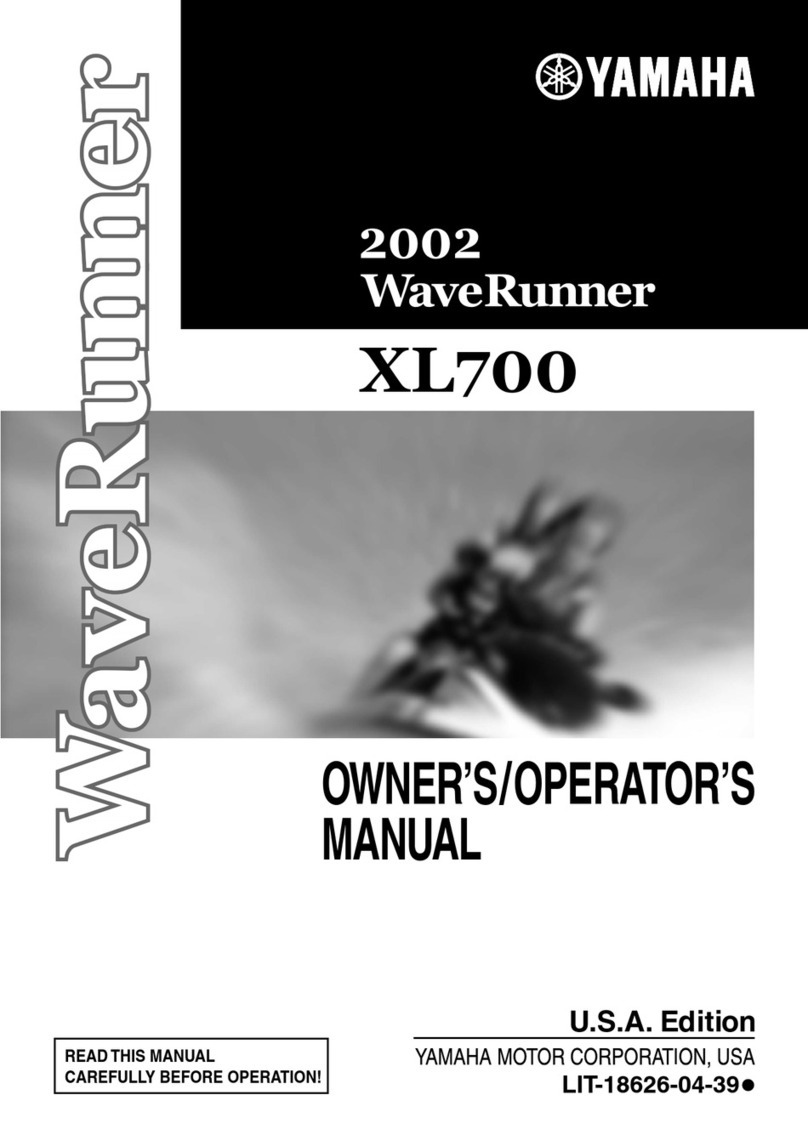
Yamaha
Yamaha XL700 WaveRunner 2001 Owner's/operator's manual

Grady-White Boats
Grady-White Boats Marlin 300 owner's manual
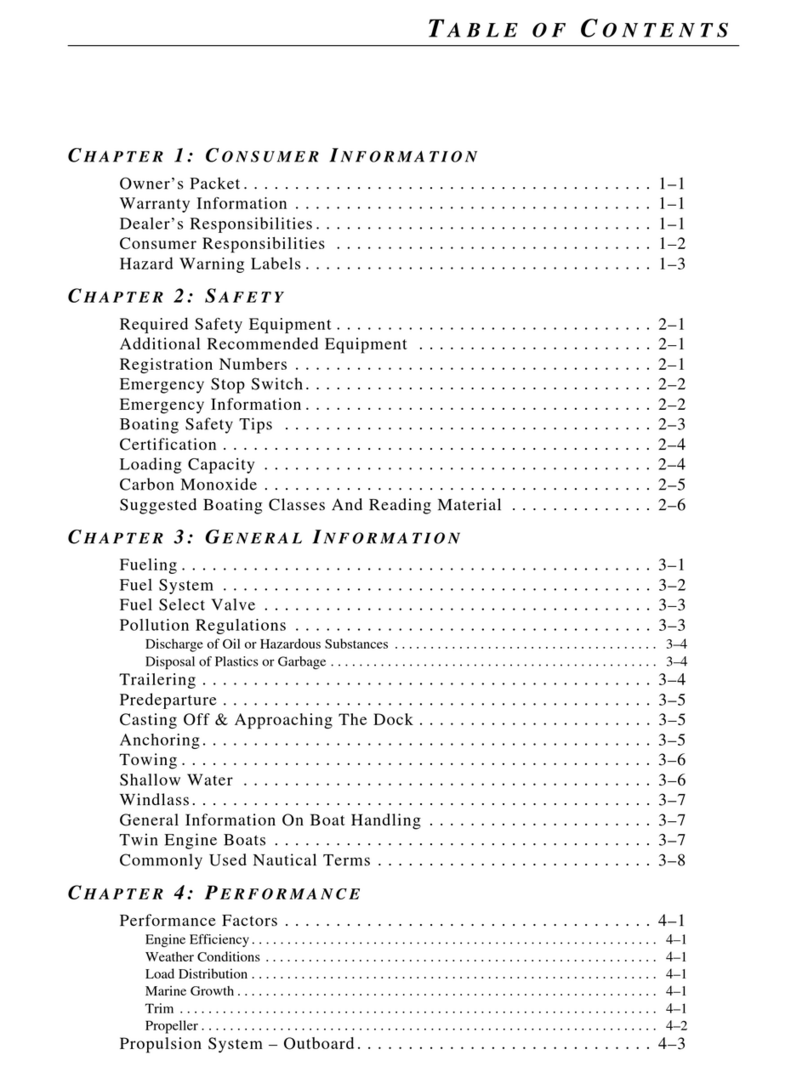
Grady-White
Grady-White Bimini 306 user manual
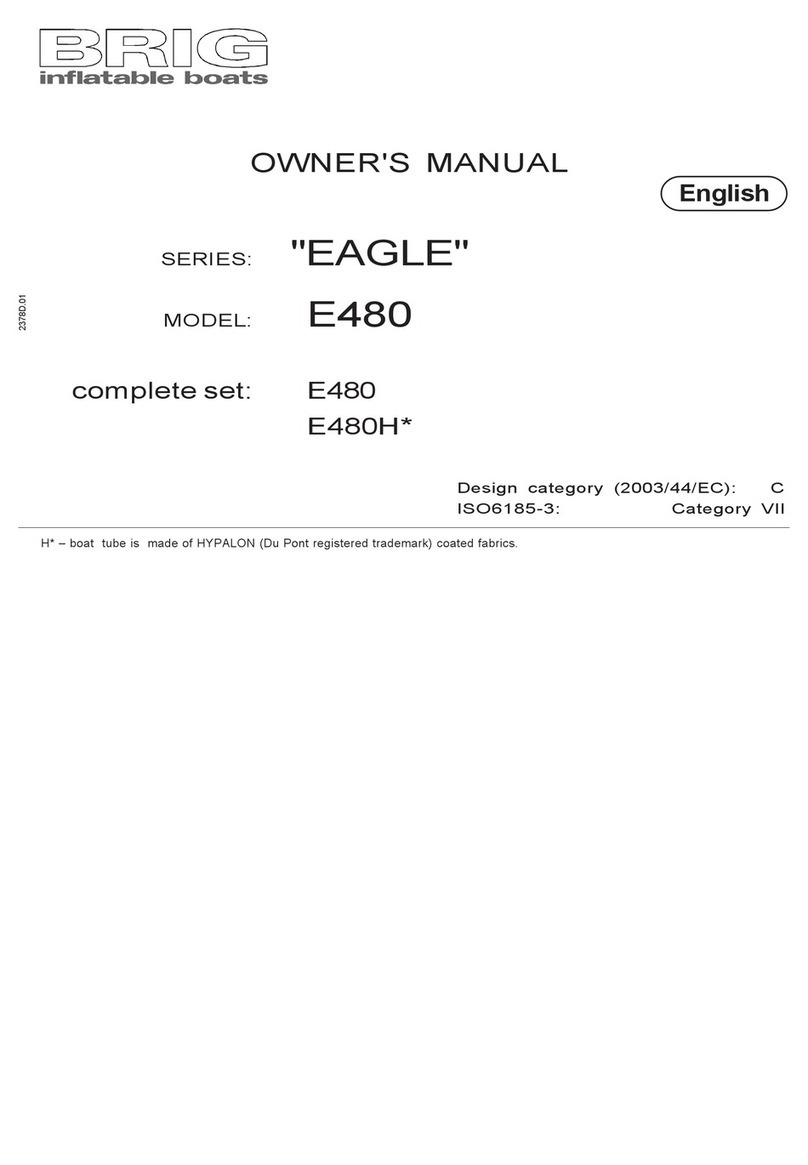
BRIG
BRIG E480 owner's manual


